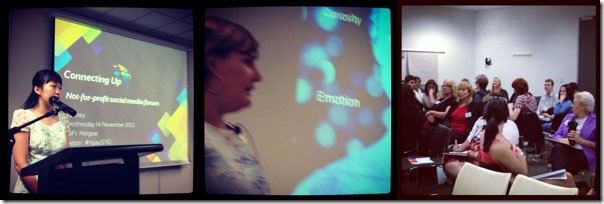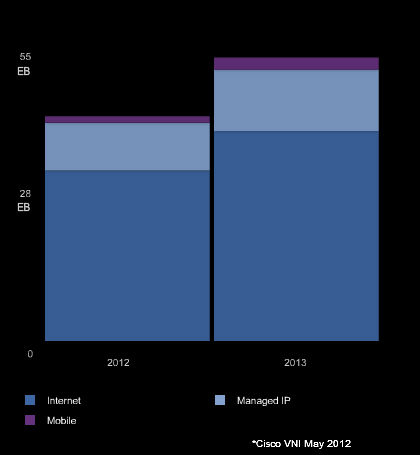
Connecting Up is a not for profit organisation that provides vital products, resources and programs designed to make the Australian not for profit and community sector stronger and more resilient. As part of this charter, Connecting Up recently held a social media forum in Sydney, Melbourne and Adelaide, showcasing the work of local organisations and sharing approaches and best practices.
In each of the locations I delivered a keynote address designed to set the scene – “Signs on the Road Ahead”. Rather than covering the basics of digital strategy and planning, many not for profits have moved beyond the social media basics and are looking for more targeted information. The aim was to provide communicators with a heads up on some of the trends and disruptions taking place in the world of digital communications. From this starting point, the participants then heard case studies from innovators working with not for profit organisations based in each city – rounding out a fantastic day with Q+A and an inspirational wrap up from Connecting Up’s Ben Teoh.
Adelaide – the hotbed of social media innovation
I am always amazed at the vibrance and innovation that emanates from the social media scene in Adelaide. The evening before the forum I was able to spend some time with some of the speakers and some of the energetic people who drive much of the online creativity coming out of Adelaide. It was clear that social media is maturing as a business discipline and Adelaide businesses are fortunate to be able to call upon professionals like Michelle Prak and Mal Chia.
During the presentation from Ben Osborne (University of Adelaide), many around the room were hastily taking notes and jotting down tips for handling challenging and sometimes volatile communities. His communications and crisis management flow chart was a huge hit and showed just how much planning and thought had gone into not only handling issues, but generating engagement and activating students across the campus.
Petra Durvocinova from RiAus sent all the geeks in the audience into paroxysms of bliss talking about science, story telling and community building. Linking curiosity, emotion, imagination and research together, Petra explained how storytelling can help audiences discover the wonders of science. The use of Livestreaming was a great opportunity to test and learn for RiAus, but the identification and nurturing of those passionate science communicators within the community was seen as essential to the long term success of their social media efforts.
Noriko Wynn from Conservation Council SA shared an in-depth dive into the world of Facebook ads and campaigns. Working not only in social media but across a range of communications and media, Noriko explained that the challenge was that sometimes there was too much to say. Social can accordingly, plan an important role in creating relevant and target communications.

Sydney – the niche and the scale
I was still a little jetlagged for the Sydney event, but a jolt of strong coffee soon had me ready for a full audience.
Rafi Cooper from WSPA delved into the narrative structure of digital storytelling. Using public narrative to focus and drive change and action (self->us->now), Rafi showed how WSPA campaigns were able to achieve impact at scale via social media. He did hint that WSPA have an advantage thanks to plenty of good stories and cute images of animals.
Yves Calamette from ACON shared a great – but niche case study on the power of social media to engage men on the topic of HIV prevention. While there was a niche focus for the campaign, Yves was able to show specific impact, ROI and best practices that are now being extended for an upcoming campaign.
Dae Levine from Republic of Everyone showcased how social media can help connect policy, planning and persuasion, presenting a case study on the Say Yes campaign. Integrated planning and digital strategy, events, installations, social proof and widespread educative communications were all used to influence the public debate around climate change and carbon pricing. While not all not for profit organisations can work on such a scale, Dae explained how various elements slotted together to create an overall impact. (And yes, the campaign was successful – with a carbon tax now in effect in Australia)
Treassa Joseph hit to podium like a dynamo. Armed with data analytics and a geek’s passion for statistics, Treassa introduced the audience to Twitter, Tweetups and Twitter festivals and showed how social media can mobilise a community to come together and take action around a cause. Expect to see more non profit tweetups in the near future!
Melbourne – from grass root to the oak tree
Cate Lawrence talked through the Green Renters experience – cultivating a niche community with style and grace on a shoestring budget. Many in the room marvelled at Cate’s grasp of social media and the impact that a very small team (see the presentation) can have when focused on the most important channels.
Chris Roberts from the Brotherhood of St Lawrence provided a great case study on how social media can be integrated into advocacy programs. Their efforts focused on a dental care initiative – and required audience education, influencer management, leveraging of existing marketing and integration of all channels towards very specific objectives. Again, this campaign was considered a success with dental now covered as part of the government’s Medicare scheme.
Daniel Lewis-Toakley from the Oaktree Foundation stepped through the Live Below the Line campaign that challenged Australians to live on $2 a day and share their experience via social media. The approach again followed the public narrative storytelling arc to create champions, engage a community and track engagement towards success. Another great not for profit success, the campaign showed the power of enabling a community not just corralling it.
Richenda Vermuelen from ntegrity provided a deep dive into the social media activation of a blogger program for World Vision. From the detailed selection process, storytelling approaches and on-the-ground management, Richenda stepped through the pitfalls and benefits that come from working with bloggers. It was a great presentation for any not for profit wanting to tap into the social media space.
 There are few trend reports that generate the kind of excitement that Mary Meeker is able to elicit. The well known partner at VC group Kleiner Perkins Caulfield and Byers has just released a year-end update to her 2012 internet trends presentation. It is an 88 slide information overload that will provide plenty to ponder during your holiday break.
There are few trend reports that generate the kind of excitement that Mary Meeker is able to elicit. The well known partner at VC group Kleiner Perkins Caulfield and Byers has just released a year-end update to her 2012 internet trends presentation. It is an 88 slide information overload that will provide plenty to ponder during your holiday break.





